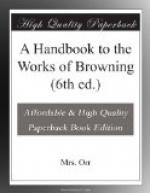VII. He always uses the measure most appropriate to his subject, whether it be the ten-syllabled blank verse which makes up “The Ring and the Book,” the separate dramatic monologues, and nearly all the dramas, or the heroic rhymed verse which occurs in “Sordello” and “Fifine at the Fair;” or one of the lyrical measures, of which his slighter poems contain almost, if not quite, every known form.[6]
VIII. He takes no liberties with unusual measures; though he takes any admissible liberty with the usual measures, which will interrupt their monotony, and strengthen their effect.
IX. He eschews many vulgarisms or inaccuracies which custom has sanctioned, both in prose and verse, such as, “thou wert;” “better than them all;” “he need not;” “he dare not.” The universal “I had better;” “I had rather,” is abhorrent to him.[7]
X. No prosaic turns or tricks of language are ever associated in his verse with a poetic mood.
THE CONTINUOUS CHARACTER OF HIS WORK.
The writer of a handbook to Mr. Browning’s poetry must contend with exceptional difficulties, growing out of what I have tried to describe as the unity in variety of Mr. Browning’s poetic life. This unity of course impresses itself on his works; and in order to give a systematic survey of them, we must treat as a collection of separate facts what is really a living whole; and seek to give the impression of that whole by a process of classification which cuts it up alive. Mr. Browning’s work is, to all intents and purposes, one group; and though we may divide and subdivide it for purposes of illustration, the division will be always more or less artificial, and, unless explained away, more or less misleading. We cannot even divide it into periods, for if the first three poems represent the author’s intellectual youth, the remainder are one long maturity; while even in these the poetic faculty shows itself full-grown. We cannot trace in it the evidence of successive manners like those of Raphael, or successive moods like those of Shakespeare; or, if we do, this is neutralized by the simple fact that Mr. Browning’s productive career has been infinitely longer than was Raphael’s, and considerably so than Shakespeare’s; and that changes which meant the development of a genius in their case, mean the course of a life in his.
And this is the central fact of the case. Mr. Browning’s work is himself. His poetic genius was in advance of his general growth, but it has been subject to no other law. “The Ring and the Book” was written at what may be considered the turning-point of a human life. It was in some degree a turning-point in the author’s artistic career: for most of his emotional poems were published before, and most of the argumentative after it; and in this sense his work may be said to divide itself into two. But the division is useless for our purpose. The Browning of the second period is the Browning of the first, only in a more crystallized form. No true boundary line can be drawn even here.




